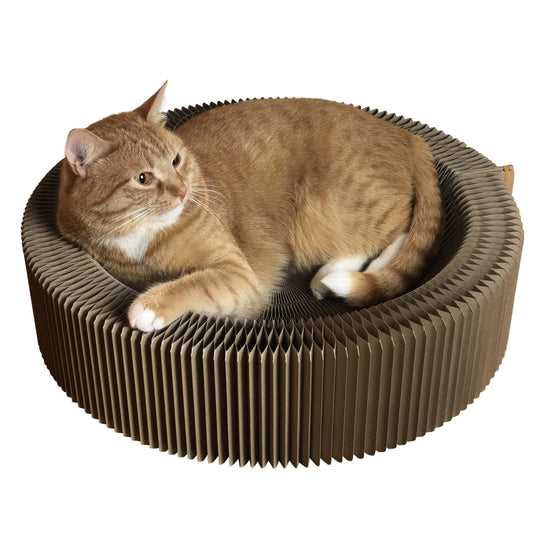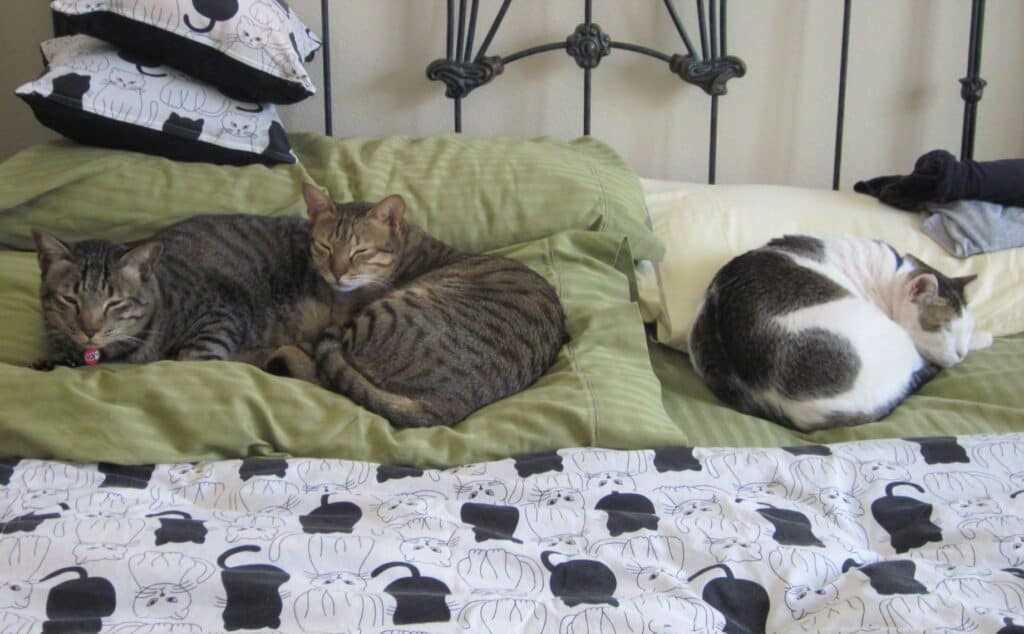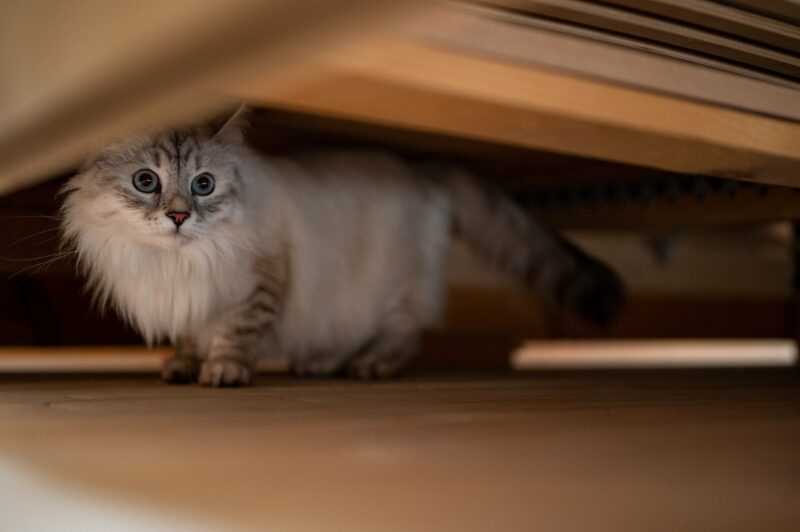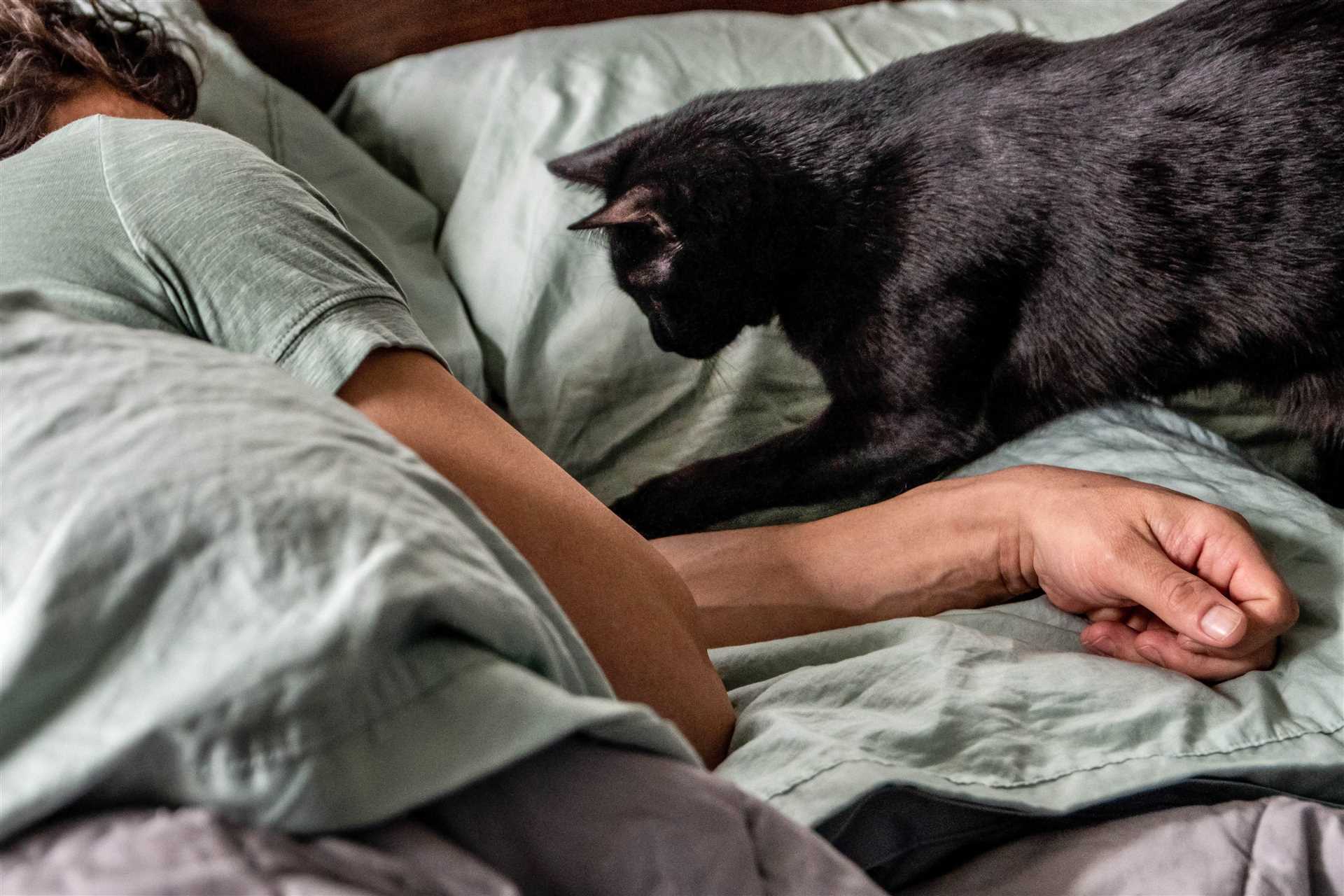



Consider placing a cozy alternative nearby. A soft bed or blanket in a warm spot can entice a furry companion to curl up there instead. Cats love comfort, and providing an appealing option can shift their focus.
Utilize scent deterrents. Cats often dislike citrus scents. Spraying a diluted citrus solution around the boundaries of the sleeping area can create an uninviting atmosphere for them. Just ensure the spray is pet-safe.
Establish clear boundaries with training. When a feline attempts to leap onto the mattress, gently but firmly redirect them to their designated resting area. Consistency is key; over time, they’ll learn the limits of their territory.
Incorporate physical barriers. Using a bed cover or a protective layer can discourage them from settling in. Some covers are specifically designed to be unappealing to pets, making the surface less inviting.
Engage in regular playtime. Keeping a furry friend entertained can reduce their urge to invade personal spaces. Interactive toys or scheduled play sessions can help redirect their energy and attention elsewhere.
Strategies for a Bed-Free Zone

Creating a designated space for relaxation is key. Provide a cozy alternative, like a plush cat bed or a blanket in a sunny spot. This encourages lounging away from my human’s sleeping area. Be sure to make it appealing with soft textures and familiar scents.
Deterrents and Distractions
Using safe deterrents can discourage unwanted visits. Try placing double-sided tape or aluminum foil on the bed; the unfamiliar texture will keep paws at bay. Additionally, engaging toys can redirect attention. Interactive toys or puzzle feeders stimulate and entertain, making my presence in the bedroom less enticing.
Consistent Routine

Establishing a routine can help reinforce boundaries. Regular playtime and feeding schedules create a sense of predictability, reducing the urge to sneak onto the mattress. Pair this with positive reinforcement–offering treats when I choose my own space promotes good behavior. For more tips on ensuring a clean environment, check out the best litter robots for cats.
Implementing Physical Barriers to Your Bed

Consider placing a pet gate at the entrance of the bedroom. This creates a clear boundary that makes it harder for furry friends to enter the space.
Try using a bed skirt or decorative fabric that hangs low to the ground. This can deter curious paws from climbing up by removing easy access.
Invest in a bed with high sides or a platform style. These designs can prevent access from all angles, making it a challenge for any adventurous pet.
Another option is to place double-sided tape or a similar sticky material on the edges of the mattress. The unexpected texture can discourage unwanted jumping.
Blocking the area with furniture can also work. Positioning a dresser or chair strategically can limit the paths available for entry.
Lastly, consider using a motion-activated pet deterrent. These devices emit a harmless spray or sound that can startle and dissuade attempts to jump up.
Creating Alternative Comfortable Spaces for Your Feline Friend

Set up a cozy corner with a soft blanket and some toys. A small cat tree or a plush bed in a quiet area can attract attention away from the sleeping spot you prefer. Position it near a window for sunbathing opportunities.
Consider a box or a tent filled with crumpled paper or soft cushions. Cats love enclosed spaces; it provides them with a sense of security. This can also become their personal retreat.
Use a variety of textures. Cats enjoy different materials, so include fleece, cotton, and sisal in their designated lounging area. Rotate items periodically to keep the environment stimulating.
Incorporate vertical spaces. Install shelves or a cat condo to give height options. Climbing and perching can divert them from seeking comfort on your bedding.
Make use of pheromone diffusers to create a calming atmosphere. This can encourage relaxation in their own space, steering them away from your sleeping area.
Add interactive elements like feather wands or laser pointers to engage their playful side. Tired cats are less likely to invade your space during the night.
FAQ:
What are some reasons my cat might want to sleep on my bed?
Cats are naturally drawn to warm, soft places, and your bed offers both. It’s a cozy spot that provides comfort and safety. Additionally, your scent is present on the bed, which can be reassuring for your cat. They may also want to be near you for companionship or simply because they enjoy your company while you sleep.
How can I discourage my cat from jumping on my bed at night?
To keep your cat off the bed at night, consider creating a designated sleeping area for them with comfortable bedding away from your room. You can also use deterrents like double-sided tape on your bed’s edges, as cats tend to dislike sticky surfaces. Additionally, providing engaging toys or activities before bedtime can help tire them out, making them less likely to seek out your bed.
Are there specific training methods to keep my cat off the bed?
Yes, positive reinforcement can be effective. When your cat chooses to sleep in their designated area instead of your bed, reward them with treats or affection. Consistency is key, so ensure that everyone in the household follows the same rules. Gradually, your cat will learn that their own space is just as appealing as your bed.
What if my cat keeps returning to my bed despite my efforts?
If your cat persistently returns to your bed, it may require more creative solutions. Try placing a few obstacles on your bed, like pillows or laundry, to make it less inviting. Using a cat repellent spray or noise deterrents when they jump up can also be helpful. Ensure that their own resting space is appealing, perhaps by placing it in a warm, sunny spot or adding their favorite blanket.
Is it harmful for my cat to sleep on my bed?
While it’s not inherently harmful for your cat to sleep on your bed, it can lead to disruptions in your sleep if they are active at night. Additionally, depending on allergies or sensitivities, sharing a bed with your pet may not be ideal. If you prefer to keep them off the bed for personal reasons, implementing boundaries can help maintain a harmonious living situation for both you and your cat.
Consider placing a cozy alternative nearby. A soft bed or blanket in a warm spot can entice a furry companion to curl up there instead. Cats love comfort, and providing an appealing option can shift their focus.
Utilize scent deterrents. Cats often dislike citrus scents. Spraying a diluted citrus solution around the boundaries of the sleeping area can create an uninviting atmosphere for them. Just ensure the spray is pet-safe.
Establish clear boundaries with training. When a feline attempts to leap onto the mattress, gently but firmly redirect them to their designated resting area. Consistency is key; over time, they’ll learn the limits of their territory.
Incorporate physical barriers. Using a bed cover or a protective layer can discourage them from settling in. Some covers are specifically designed to be unappealing to pets, making the surface less inviting.
Engage in regular playtime. Keeping a furry friend entertained can reduce their urge to invade personal spaces. Interactive toys or scheduled play sessions can help redirect their energy and attention elsewhere.
Strategies for a Bed-Free Zone

Creating a designated space for relaxation is key. Provide a cozy alternative, like a plush cat bed or a blanket in a sunny spot. This encourages lounging away from my human’s sleeping area. Be sure to make it appealing with soft textures and familiar scents.
Deterrents and Distractions
Using safe deterrents can discourage unwanted visits. Try placing double-sided tape or aluminum foil on the bed; the unfamiliar texture will keep paws at bay. Additionally, engaging toys can redirect attention. Interactive toys or puzzle feeders stimulate and entertain, making my presence in the bedroom less enticing.
Consistent Routine

Establishing a routine can help reinforce boundaries. Regular playtime and feeding schedules create a sense of predictability, reducing the urge to sneak onto the mattress. Pair this with positive reinforcement–offering treats when I choose my own space promotes good behavior. For more tips on ensuring a clean environment, check out the best litter robots for cats.
Implementing Physical Barriers to Your Bed

Consider placing a pet gate at the entrance of the bedroom. This creates a clear boundary that makes it harder for furry friends to enter the space.
Try using a bed skirt or decorative fabric that hangs low to the ground. This can deter curious paws from climbing up by removing easy access.
Invest in a bed with high sides or a platform style. These designs can prevent access from all angles, making it a challenge for any adventurous pet.
Another option is to place double-sided tape or a similar sticky material on the edges of the mattress. The unexpected texture can discourage unwanted jumping.
Blocking the area with furniture can also work. Positioning a dresser or chair strategically can limit the paths available for entry.
Lastly, consider using a motion-activated pet deterrent. These devices emit a harmless spray or sound that can startle and dissuade attempts to jump up.
Creating Alternative Comfortable Spaces for Your Feline Friend

Set up a cozy corner with a soft blanket and some toys. A small cat tree or a plush bed in a quiet area can attract attention away from the sleeping spot you prefer. Position it near a window for sunbathing opportunities.
Consider a box or a tent filled with crumpled paper or soft cushions. Cats love enclosed spaces; it provides them with a sense of security. This can also become their personal retreat.
Use a variety of textures. Cats enjoy different materials, so include fleece, cotton, and sisal in their designated lounging area. Rotate items periodically to keep the environment stimulating.
Incorporate vertical spaces. Install shelves or a cat condo to give height options. Climbing and perching can divert them from seeking comfort on your bedding.
Make use of pheromone diffusers to create a calming atmosphere. This can encourage relaxation in their own space, steering them away from your sleeping area.
Add interactive elements like feather wands or laser pointers to engage their playful side. Tired cats are less likely to invade your space during the night.
FAQ:
What are some reasons my cat might want to sleep on my bed?
Cats are naturally drawn to warm, soft places, and your bed offers both. It’s a cozy spot that provides comfort and safety. Additionally, your scent is present on the bed, which can be reassuring for your cat. They may also want to be near you for companionship or simply because they enjoy your company while you sleep.
How can I discourage my cat from jumping on my bed at night?
To keep your cat off the bed at night, consider creating a designated sleeping area for them with comfortable bedding away from your room. You can also use deterrents like double-sided tape on your bed’s edges, as cats tend to dislike sticky surfaces. Additionally, providing engaging toys or activities before bedtime can help tire them out, making them less likely to seek out your bed.
Are there specific training methods to keep my cat off the bed?
Yes, positive reinforcement can be effective. When your cat chooses to sleep in their designated area instead of your bed, reward them with treats or affection. Consistency is key, so ensure that everyone in the household follows the same rules. Gradually, your cat will learn that their own space is just as appealing as your bed.
What if my cat keeps returning to my bed despite my efforts?
If your cat persistently returns to your bed, it may require more creative solutions. Try placing a few obstacles on your bed, like pillows or laundry, to make it less inviting. Using a cat repellent spray or noise deterrents when they jump up can also be helpful. Ensure that their own resting space is appealing, perhaps by placing it in a warm, sunny spot or adding their favorite blanket.
Is it harmful for my cat to sleep on my bed?
While it’s not inherently harmful for your cat to sleep on your bed, it can lead to disruptions in your sleep if they are active at night. Additionally, depending on allergies or sensitivities, sharing a bed with your pet may not be ideal. If you prefer to keep them off the bed for personal reasons, implementing boundaries can help maintain a harmonious living situation for both you and your cat.
Consider placing a cozy alternative nearby. A soft bed or blanket in a warm spot can entice a furry companion to curl up there instead. Cats love comfort, and providing an appealing option can shift their focus.
Utilize scent deterrents. Cats often dislike citrus scents. Spraying a diluted citrus solution around the boundaries of the sleeping area can create an uninviting atmosphere for them. Just ensure the spray is pet-safe.
Establish clear boundaries with training. When a feline attempts to leap onto the mattress, gently but firmly redirect them to their designated resting area. Consistency is key; over time, they’ll learn the limits of their territory.
Incorporate physical barriers. Using a bed cover or a protective layer can discourage them from settling in. Some covers are specifically designed to be unappealing to pets, making the surface less inviting.
Engage in regular playtime. Keeping a furry friend entertained can reduce their urge to invade personal spaces. Interactive toys or scheduled play sessions can help redirect their energy and attention elsewhere.
Strategies for a Bed-Free Zone

Creating a designated space for relaxation is key. Provide a cozy alternative, like a plush cat bed or a blanket in a sunny spot. This encourages lounging away from my human’s sleeping area. Be sure to make it appealing with soft textures and familiar scents.
Deterrents and Distractions
Using safe deterrents can discourage unwanted visits. Try placing double-sided tape or aluminum foil on the bed; the unfamiliar texture will keep paws at bay. Additionally, engaging toys can redirect attention. Interactive toys or puzzle feeders stimulate and entertain, making my presence in the bedroom less enticing.
Consistent Routine

Establishing a routine can help reinforce boundaries. Regular playtime and feeding schedules create a sense of predictability, reducing the urge to sneak onto the mattress. Pair this with positive reinforcement–offering treats when I choose my own space promotes good behavior. For more tips on ensuring a clean environment, check out the best litter robots for cats.
Implementing Physical Barriers to Your Bed

Consider placing a pet gate at the entrance of the bedroom. This creates a clear boundary that makes it harder for furry friends to enter the space.
Try using a bed skirt or decorative fabric that hangs low to the ground. This can deter curious paws from climbing up by removing easy access.
Invest in a bed with high sides or a platform style. These designs can prevent access from all angles, making it a challenge for any adventurous pet.
Another option is to place double-sided tape or a similar sticky material on the edges of the mattress. The unexpected texture can discourage unwanted jumping.
Blocking the area with furniture can also work. Positioning a dresser or chair strategically can limit the paths available for entry.
Lastly, consider using a motion-activated pet deterrent. These devices emit a harmless spray or sound that can startle and dissuade attempts to jump up.
Creating Alternative Comfortable Spaces for Your Feline Friend

Set up a cozy corner with a soft blanket and some toys. A small cat tree or a plush bed in a quiet area can attract attention away from the sleeping spot you prefer. Position it near a window for sunbathing opportunities.
Consider a box or a tent filled with crumpled paper or soft cushions. Cats love enclosed spaces; it provides them with a sense of security. This can also become their personal retreat.
Use a variety of textures. Cats enjoy different materials, so include fleece, cotton, and sisal in their designated lounging area. Rotate items periodically to keep the environment stimulating.
Incorporate vertical spaces. Install shelves or a cat condo to give height options. Climbing and perching can divert them from seeking comfort on your bedding.
Make use of pheromone diffusers to create a calming atmosphere. This can encourage relaxation in their own space, steering them away from your sleeping area.
Add interactive elements like feather wands or laser pointers to engage their playful side. Tired cats are less likely to invade your space during the night.
FAQ:
What are some reasons my cat might want to sleep on my bed?
Cats are naturally drawn to warm, soft places, and your bed offers both. It’s a cozy spot that provides comfort and safety. Additionally, your scent is present on the bed, which can be reassuring for your cat. They may also want to be near you for companionship or simply because they enjoy your company while you sleep.
How can I discourage my cat from jumping on my bed at night?
To keep your cat off the bed at night, consider creating a designated sleeping area for them with comfortable bedding away from your room. You can also use deterrents like double-sided tape on your bed’s edges, as cats tend to dislike sticky surfaces. Additionally, providing engaging toys or activities before bedtime can help tire them out, making them less likely to seek out your bed.
Are there specific training methods to keep my cat off the bed?
Yes, positive reinforcement can be effective. When your cat chooses to sleep in their designated area instead of your bed, reward them with treats or affection. Consistency is key, so ensure that everyone in the household follows the same rules. Gradually, your cat will learn that their own space is just as appealing as your bed.
What if my cat keeps returning to my bed despite my efforts?
If your cat persistently returns to your bed, it may require more creative solutions. Try placing a few obstacles on your bed, like pillows or laundry, to make it less inviting. Using a cat repellent spray or noise deterrents when they jump up can also be helpful. Ensure that their own resting space is appealing, perhaps by placing it in a warm, sunny spot or adding their favorite blanket.
Is it harmful for my cat to sleep on my bed?
While it’s not inherently harmful for your cat to sleep on your bed, it can lead to disruptions in your sleep if they are active at night. Additionally, depending on allergies or sensitivities, sharing a bed with your pet may not be ideal. If you prefer to keep them off the bed for personal reasons, implementing boundaries can help maintain a harmonious living situation for both you and your cat.








